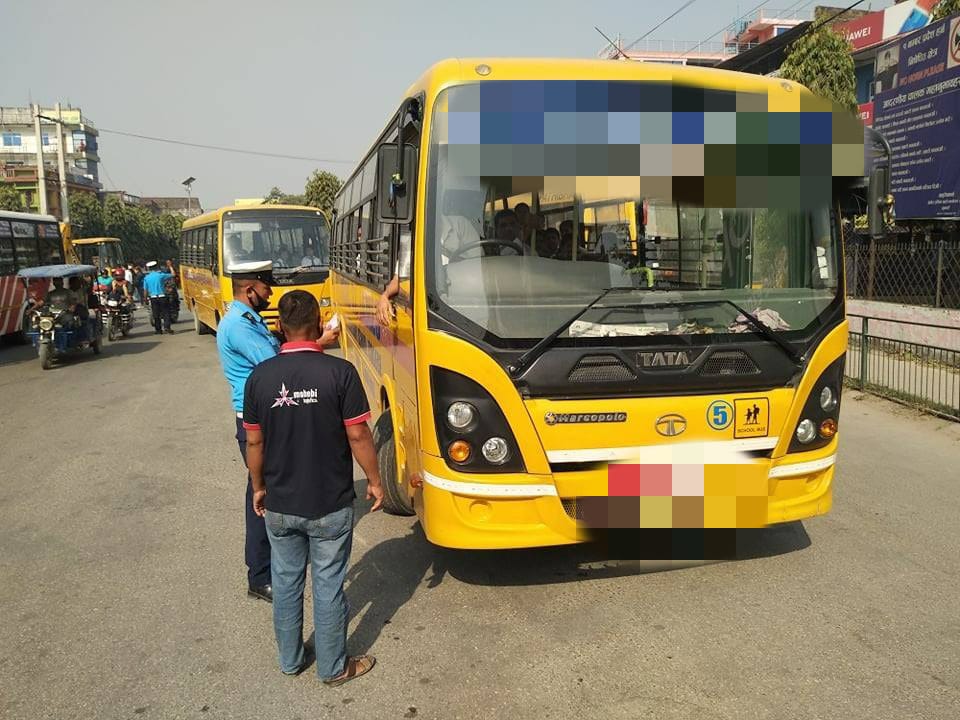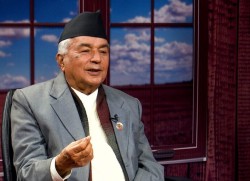Nepal

The tragic death of a student this past week has brought school transport into focus. This has raised concerns among parents who use this mode of conveyance to send their children to school.
Ayushman Dahal, a fifth grader of Best Elementary Montessori School, Lazimpat, sustained severe head injuries last Wednesday when he hit a tree as he was sticking his head out the window of the moving bus, according to the police.
He was rushed to Tribhuvan University Teaching Hospital but died from his injuries.
Ayushman’s death has left his parents devastated, “especially my daughter – the mother of the boy – is yet to grasp what happened,” said Damodar Prasad Dawadi, the child’s maternal grandfather.
He contends that the school was negligent in hiring and training drivers and that the school management was lax in ensuring basic safety features on the bus.
“We found out that the bus did not park inside the school premises. It is the school management's responsibility to bring the children home safely,” he explained in a wailing voice.
“The school should have called us immediately. But we were informed about the incident only after the child was taken to the hospital,” he said.
Blood-stained bag
To their shock, Dawadi said, the family learnt that the bus went on to drop other students home after the incident.
Blood stains on the bus were washed clean when they inspected the vehicle at Police Circle, Durbarmarg in the evening, Dawadi continued, fighting back the tears.
Later that evening, a fellow student came to Ayushman’s home at Samakhusi to deliver the blood-stained bag.
“If only somebody had cared to pay a bit more attention on the bus, the accident could have been avoided,” he added.
“This is utter negligence by the school management. We expect those responsible will be held accountable.”
The school has yet to address the incident publicly. NepalMinute’s numerous phone calls to contact the school went unanswered.
The police arrested the bus driver, 30-year-old Roshan Adhikari, and launched an investigation into the incident.
“The bus driver has been remanded for five days, and investigation is on,” said Dinesh Raj Mainali, spokesperson at the District Police Range, Kathmandu, told NepalMinute on Friday.
The police records show 2,883 people lost their lives in 39,379 road accidents across the country in the fiscal year 2021/22.
With thousands of new vehicles coming out each year to share congested roads, the frequency of fatal road accidents involving school kids has increased too.
On June 28, a four-year-old boy studying at Mount Makalu Boarding School in Rangeli-7, Morang, died after the school bus hit him. Another five-year-old girl was seriously injured in the same incident. The bus had hit the children when it came to the school premises to pick them up.
“That’s utter negligence on part of the school management. It is their duty to ensure children are safe,” said Suprabhat Bhandari, president of the Guardian’s Association Nepal.
“Lodging a complaint against the driver is not the end solution. Officials should also be taken to task.”
Violations of government guidelines on school buses and schools are frequent.
However, erring schools are often let off the hook even as students suffer injuries in accidents during school hours, many parents complain.
On July 31, the police booked five school bus drivers for drunk driving. Actions were taken against 31 more school bus drivers on September 31 for driving under the influence.
PABSON, an umbrella organisation of the private and boarding schools in Nepal, said the boy's death was unfortunate and that schools should abide by norms.
“If the schools are found violating the rules and regulations then PABSON can cancel its membership,” said Prem Kumar Rai, who chairs its Kathmandu district executive committee.
“But we can’t go beyond that and punish them as we don’t have the authority.”
The Kathmandu Metropolitan City has a mechanism whereby parents of schoolchildren can register their grievances.
Ram Prasad Subedi, chief of the Kathmandu Metropolitan City Education Department, said: “When such issues happen, parents can complain to the metropolis.”
But it has been relegated to the bottom of the metropolis’ priorities. And many parents do not know such a mechanism even exists.
A closer inspection by NepalMinute reveals the KMC is in no position to take action against the schools.
The metropolis has the authority to issue permits for running kindergarten/pre-schools, but it does not have a database for recording the number of such schools.
“Without adequate data, we are facing difficulties in regulating and monitoring such schools,” Subedi lamented.
He conceded that the final authority is vested in the Department of Education under the Ministry of Education, Science, and Technology.
Impunity rife
According to the ministry, 35,520 schools in the country have about seven million students. While the ministry is responsible for school guidelines and safety protocols, it cannot punish them.
The ministry certifies the transport vehicle complies with the provisions of the School Bus Directives 2018.
According to the directives, every school vehicle should have the words ‘school bus’ and ‘on school duty’ written in the front and rear of the vehicle.
No school bus shall ferry passengers on roads, every school bus should have the name, address, class and blood group of children and a route chart, every bus should have a male or female helper to assist the driver for the safety of children; the maximum speed of the school bus should not be more than 40kmph.
|
School Bus Directives 2018 The exterior colour of the school bus should be golden yellow. "School Bus" should be written in black on the front and back of the school bus. If the school bus is hired, there should be a banner with the name of the school that reads "on school duty" or a plate that reads "school bus" on the front and back of the bus. School’s name, address and phone number should be mentioned. All school buses should have emergency exits on the right side of the rear half. The emergency exit at the back of the bus should be made of breakable glass. All the doors and emergency exits should be closed when the school bus is running. At least three horizontal round metal/round aluminium tube grills should be installed on both sides of the school bus. A first aid box and fire extinguisher should be placed in a visible place on the bus. Bus doors should have a reliable locking system. The glass of the window should be transparent. Bus seats should be forward-facing. No sharp or sharp objects should be protruding from any part of the seat. There should be a proper handrail in front of the seat next to the step well. A stop sign should be placed inside the bus for the purpose of helping students in getting off, boarding or crossing the road whenever required by the bus operator. No one should smoke, or consume alcohol on the school bus. |
Yet the ministry passes on the buck.
“It is the duty of the school management to take care of the school students. The school management should be responsible for any kind of accidents in school,” said ministry spokesperson Deepak Sharma.
“Accidents or crimes in schools or involving school children are handled by the police as they are criminal offences.”
Better awareness
Amid questions over the safety standards of the school buses, people in the sector say it is necessary to make children aware – very early on – of the importance of road safety.
To make young children understand the street's dangers, they should be taught that one does not cross it anyhow and anytime, but according to certain rules and specific places, that traffic lights must be respected, etc.
The children are often seen taking their hands out, sticking their necks out of bus windows, throwing chocolate and noodle wrappers, spitting, and teasing the passers-by.
“We conduct traffic awareness programmes in schools at times,” PABSON’s Rai claimed. “The schools too conduct traffic awareness programmes on their own to inform children about traffic rules and regulations and safety measures.”
But all parents invariably want that to be the rule rather than an exception to prevent such unfortunate incidents in the future, according to Ashish Gajurel, a transport and traffic engineer.
Many of these buses ferrying school children are hired. “Public vehicles are often in a rush. Schools should use their own vehicles for pick ups and drop offs,” he said, calling on schools to get the fitness of vehicles and other works done in time and abide by laws.
"We should consider the right to safe transportation along with the right to education," he said, suggesting the Curriculum Development Centre include courses on road safety and traffic in schools textbooks.
The parents should also be alert to the transportation service provided by the schools. Any weaknesses should be brought to the school management’s notice immediately. Also, they can lodge a complaint with the police, Gajurel continued.
"We have to stop the blame game and come up with a holistic approach,” he said, urging, “Both parents and schools have to work in tandem and create an atmosphere of safety for our kids."






